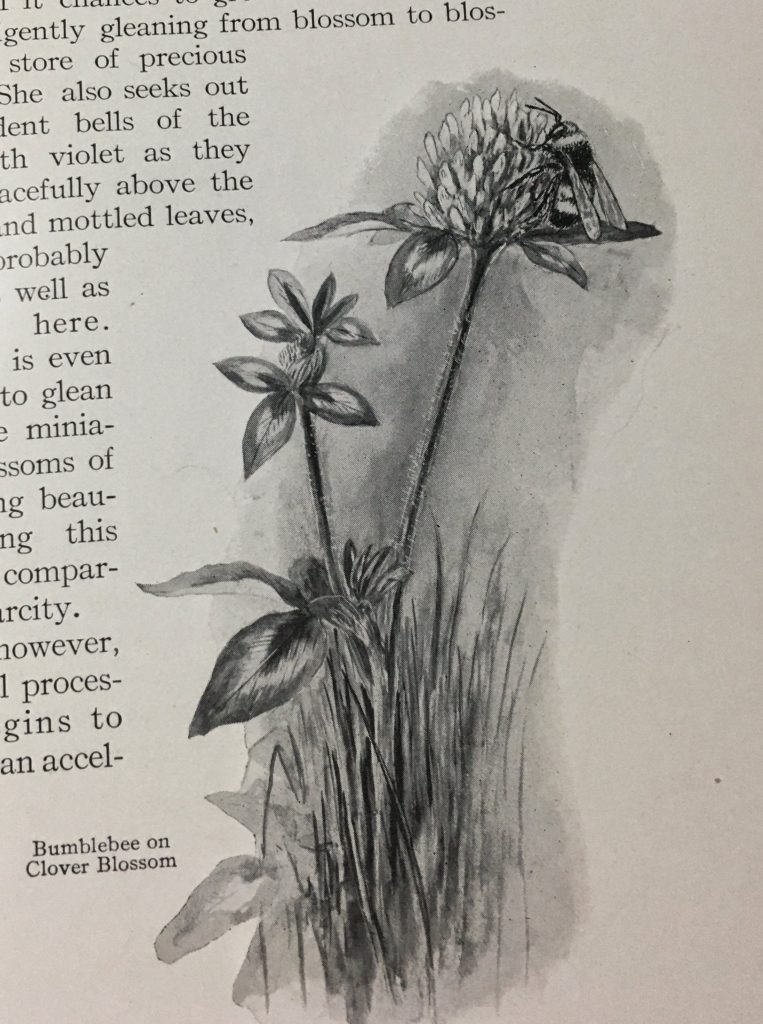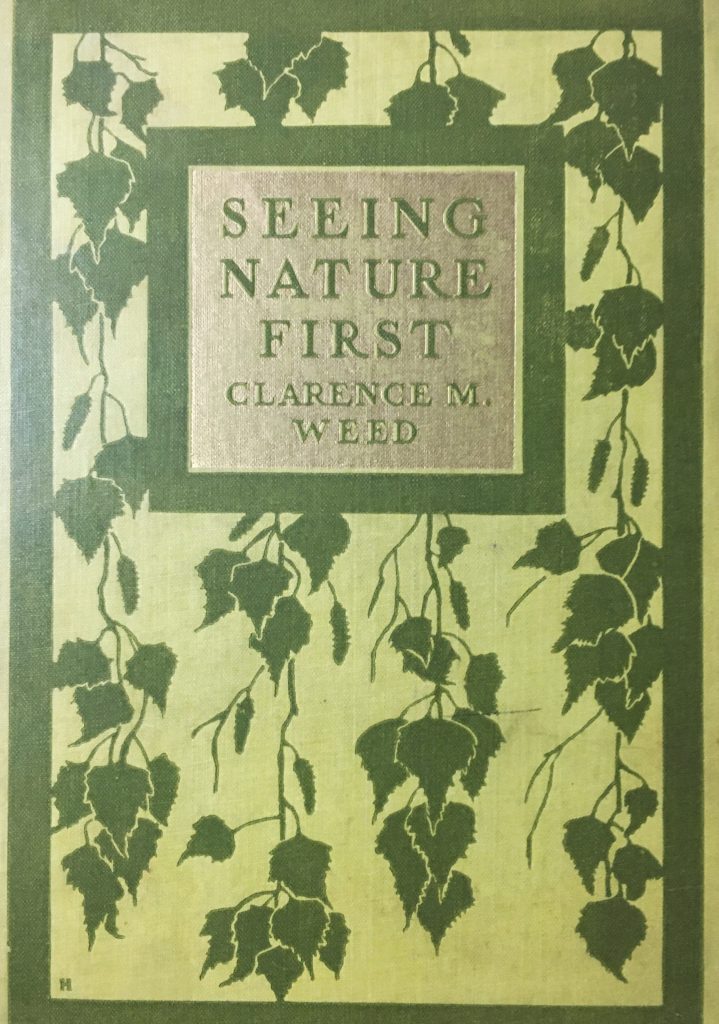
So the study of trees in winter leads us directly into other fields of knowledge, — the great world of insects that live upon the trunk and branches, the parasitic fungi that develop in the bark, the birds that search for winter insects. For in nature, nothing lives by itself alone: it is related in a thousand ways to other living things. To this is largely due the fascination of the outdoor world: when you really become acquainted with the nearest tree, you find yourself on speaking terms with a large part of the universe.
FOR AN HISTORICAL BIOLOGIST WITHOUT EVEN A WIKIPEDIA PAGE TO HIS NAME, CLARENCE M. WEED OFFERS THE READER MANY MOMENTS OF WONDER AND INSIGHT. I am baffled as to why he is so unknown; his knowledge of botany and ecology is impressive and seems at moments ahead of its time (or at least, quite up to date for 1913). (To be accurate, these is, in fact, a Wikipedia page for Clarence Weed; but that is for Clarence R. Weed, a football and basketball coach of the same time period.) Having read just one of Weed’s books (the naturalist, not the coach) and ordered a second one, I am quite convinced that he could have gained renown as an author; I will endeavor to convince readers of that with this post. “Seeing Nature First” begins as a guide for teens and adults into how to perceive and interpret natural phenomena throughout the seasons. The first several chapters, set in springtime, include numerous examples of fascinating facts about plants and insects (Weed was an entomologist by profession.). I learned new things, myself. For instance, have known for ages that skunk cabbage flowers, which often emerge while snow still covers the ground, actually heat the air around them, attracting early insect pollinators seeking warmth. What I never knew was how this trick was done. According to Weed, “the hoods [of skunk cabbage flowers] not only furnish protection from the elements, but the purplish tissues of which they are composed oxidize so rapidly that the temperature within is raised above that of the air outside.” I was amazed to find this fact was already known over 100 years ago.
ULTIMATELY, HOWEVER, THE BOOK IS UNEVEN; CHAPTERS THAT FASCINATE ARE MIXED WITH ONES THAT ELICIT ONLY TEDIUM. At times, I even wonder if Weed didn’t simply sweep every paper on his desk into a pile, sort it by seasons (affording some sense of structure) and sending the whole mess off to the publisher. The audience varies, too. Most “chapters” are only a few pages in length. The best ones, in my opinion, are geared toward a lay audience of potential Nature enthusiasts. Other articles seem more like abstracts of reports on efforts to keep various insect pests under control. Then there is an article about frogs changing colors — admittedly a worthy topic — that consists of several pages of dry details about different captive frogs in different enclosures on various days and differing hours on those days. As field notes for a short essay, they work well. As flowing text to engage the reader, they are a disaster.
THEN ANOTHER PAGE OR PASSAGE POPS OUT AT THE READER, AND HE OR SHE IS LEFT IN AWE. Did you know, for instance, that early season flowers pollinated by bumblebees. such as the columbine, tend to be quite large, because they attract the queens? Then, by midsummer, the bumblebee-pollinated flowers are noticeably smaller, because the worker bees have joined her in the colony? Or have you ever been curious about how a closed gentian flower gets pollinated? (John Burroughs even speculated that it lacks a pollinator.) According to Weed, “the worker bumblebees…have learned how to pry open the mouth of the blossom and enter for the nectar at its base, where they circle around the flower in a way to come in contact with both stamens and pistil. And they can tell from the color of the blossom whether it is young and nectar-bearing.” Wow.
IN A COUPLE OF SPOTS IN HIS WORK, WEED POINTS TO THE ECOLOGICAL PRINCIPLE OF THE BALANCE OF NATURE. I know little about the early days of ecological study, but at very least this concept was relatively new at the time. In a chapter on the ichneumon flies, Weed notes that “There are numberless ways in which nature keeps that balance of life which renders human existence upon the earth possible.” In the case of these parasitic flies that prey on caterpillars, Weed notes that they perform a necessary function, keeping those caterpillar species in check. Without them, Weed acknowledges, the caterpillars would likely “cause untold damage to forests and cultivated crops.” Indeed, in one of his drier chapters, Weed discusses efforts to control an invasive caterpillar species through use of a natural predator insect. Eventually, Weed explains, such invasive species can be made subject to the Balance of Nature: “This is the condition of most injurious insects that have been present in a given region for a long time. There are periods of scarcity and of abundance, due largely to the fluctuations in the numbers of natural enemies.”
WHAT MOST STANDS OUT TO ME ABOUT WEED’S BOOK, HOWEVER, IS THE INVITATION IT OFFERS US — PARTICULARLY THOSE OF US LIVING IN NEW ENGLAND — TO GET OUTDOORS AND MAKE NEW DISCOVERIES. The ultimate result of our time in nature is the fashioning of stories — tales that tell of the complexity and interconnectedness of the natural world. To close, here is a passage from Weed, extolling the virtues of exploring the woods in wintertime:
There is much more to be learned in the winter woods than merely to become acquainted with the different kinds of trees. Desirable as it is, such acquaintance should be but the beginning of one’s knowledge. Every tree has many stories to tell to one who will look with the seeing eye and the active mind. Such stories relate to the age of the tree, to the relations it has established with the sunlight, to its battles with its enemies, to its cooperation with its friends. Stories of all these and many other mysteries of plant life are mutely waiting interpreters in every winter landscape.
AS A POSTSCRIPT, I SHOULD MENTION BOTH THE BOOK’S ILLUSTRATOR AND A BIT ABOUT MY COPY. The illustrator is W. I. Beecroft, and his stunning, almost three-dimensional drawings are another highlight of the book. (In fact, they are considerably more impressive than the scattered black and white photographs also included.) Beecroft authored and illustrated short field guides to ferns and wildflowers, too.

My copy of this book appears to be a first edition (though there may never have been a second one). It was published in April of 1913. There is no bookseller’s stamp, but there is an inscription to Emily Mills Page, 87 High Street, Newburyport, Massachusetts, from Mother, on February 20, 1915. (I was even able to find the home on Google Maps.) The most noteworthy feature of my book, though, is its elegant though somewhat worn green-and-gilt cover. The metallic portion is actually gold, but it looks much more silvery in the image below.
